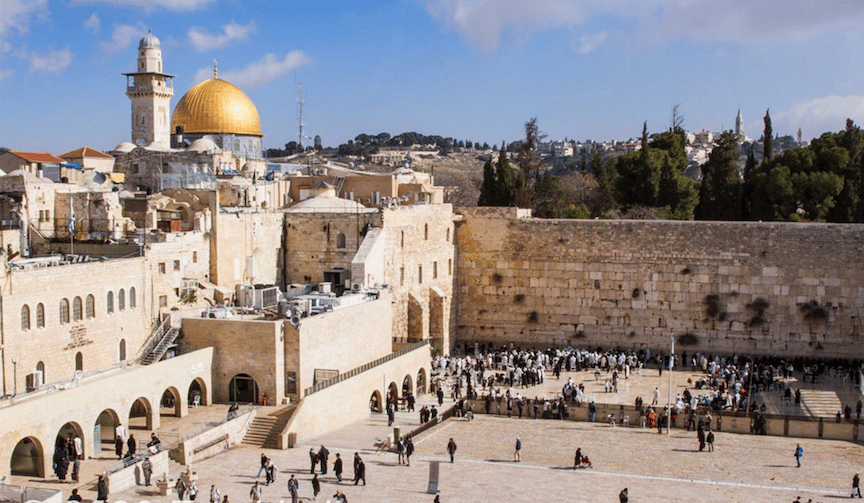
The Western Wall attracts worshippers from around the world. Photo by Eric Lindberg
By Mira Temkin
Among Jewish people, Jerusalem’s Western Wall is the holiest place on earth. The “Kotel,” as it is called in Hebrew, evokes a mystical connection to history, Judaism, and personal prayer.
People come to meditate at this sacred site and place notes with their personal prayers into the cracks between the stones. For many, being at the Western Wall creates a deep sense of spirituality. Linger for a short while and you will see visitors walking backward from the Wall out of respect for its holiness.
The Western Wall is the last remnant of the Second Temple, destroyed in 70 AD by the Romans. That devastation prompted a Jewish diaspora to other parts of the world.
But there is more to this holy site than meets the eye. As you back directly away from the Wall, turn left to the north side of the plaza and walk toward the entrance to the Western Wall Tunnels. Once through the door, you’ll climb down 50 feet to a network of tunnels that extend more than 1,600 feet. As you slowly descend the air cools, the lights grow dim and centuries of history start to reveal their secrets. You move through forgotten realms past dim chambers where Knights Templar, Seljuk Turks and others might have taken refuge. European queens like Eleanor of Aquitaine, St. John Hospitallers, Roman Cardinals and Ottoman pashas could have walked these tunnels. But did they? Modern archaeologists are searching for evidence, pieces of history that were cast aside and buried over the millennia with little thought as to what they might mean to future generations.
The tunnels consist of well-engineered passageways constructed over three millennia. They expose layers upon layers of civilization. Excavations of alternating layers of destruction and construction have unearthed prosaic artifacts like clay cooking vessels and oil lamps that once held woven linen wicks to create light. In addition to these household items, lustrous gold and silver coins stamped with profiles of ancient kings and rulers have been found here.
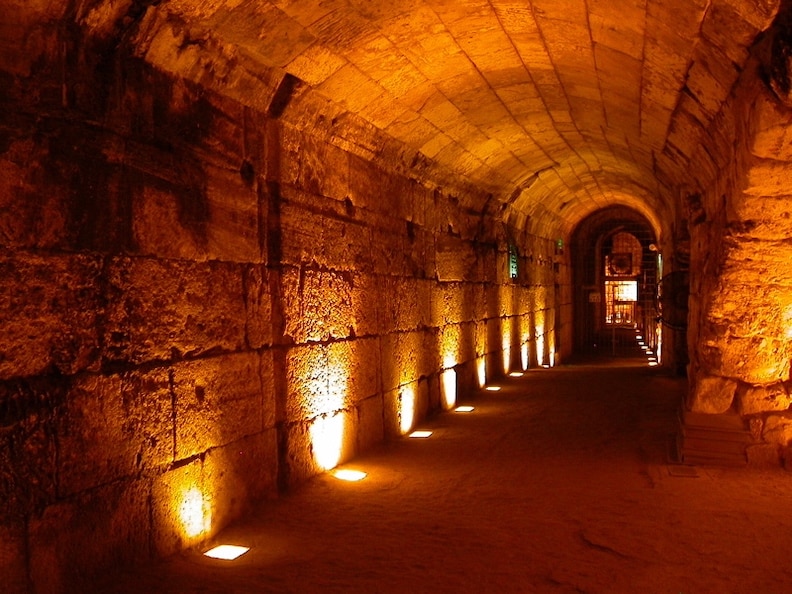
Western Wall Tunnels. Photo courtesy of the Western Wall Heritage Foundation
The tunnels also reveal a complex system of public works like cisterns that supplied water to the Temple, and quarries that provided stones to Ottoman Sultan Suleiman I, who used them to rebuild Jerusalem’s old city wall in the 16th Century. Recently discovered evidence also supports the notion that Muslim Caliphs from as early as the 7th century were widening some passageways into subterranean corridors they used to avoid the oppressive heat and noxious odors on the surface streets above.
The Ottoman Centuries
After the Crusades, Ottoman Turks gradually took control of Palestine, which they controlled for four centuries. In the middle of the 19th Century, they allowed British officials into Jerusalem to search for the tomb of King David as well as the treasures of Solomon.
Interestingly, the first British explorers were not archaeologists, but rather engineers. They were sent from London and funded by the Palestine Exploration Fund, an organization that still exists today.
The British Start Digging
One engineer, Charles Wilson, started excavating the Western Wall in 1864. He was followed by Charles Warren in 1867–70. In recognition of his pioneering efforts, there’s an arch named for Wilson at the eastern part of the Wall. The archway once supported a bridge to the Second Temple. The shafts Wilson excavated allowed diggers to see the wall’s original foundations and are still visible today.
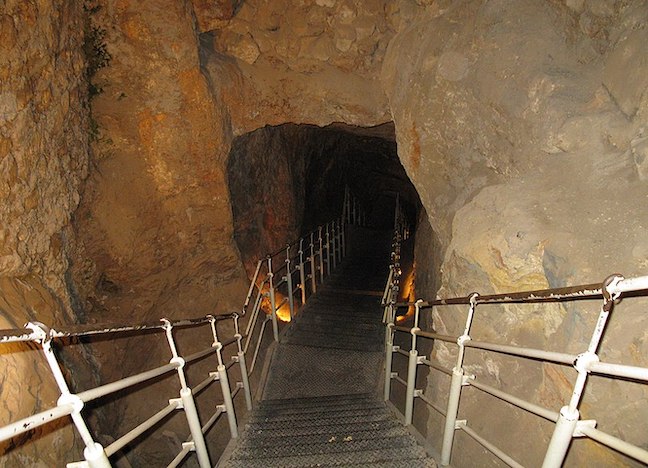
Charles Wilson’s shafts originally dug in the mid-19th century are still visible today. Photo courtesy of the Western Wall Heritage Foundation
Tunnel excavations were stopped in the mid-19th century due to political and religious conflict between Jews and Muslims over the contentious issue over where the digging could take place. Muslims were concerned about structural damage that might occur below the Dome of the Rock. Because of their justifiable concerns, the tunnels continued to hold their ancient secrets and remained an elusive mystery waiting to be discovered a century later.
Most of the real digging began after the Six Day War in 1967 when workers assigned from Israel’s Ministry of Religious Affairs dug under the Old City’s Muslim Quarter located near the Damascus Gate. The Via Dolorosa begins in this Quarter. There they discovered fascinating artifacts, jewelry, Roman pottery and earthenware, Islamic coins, and items left by the Crusaders.
The Israel Antiquities Authority is the governmental body that manages the country’s excavation projects. Controversy continues to this day on where to explore, what not to disturb, and who should lead the way.
Why is Israel Full of Archaeological Wonders?
“People from all three ancient religions – Judaism, Christianity and Islam – are interested in Biblical history and wonder what is true and what can be verified,” says Fran Alpert, co-founder with her late husband, Bernie Alpert of “Dig for a Day” Archaeological Seminars in Israel.
Adds Alpert, “They’re looking to corroborate what the text says in the Bible and the (Jewish) Talmud, as well as other scholarly works. Books talk about King Herod the Great who ruled Jerusalem from 37 to 34 BCE. He had great skills as a builder and wanted to expand the Temple Mount. The findings below the Western Wall confirm his engineering skills.”
It was King Herod who built four retaining walls around the Temple Mount so it could accommodate more worshippers. Archaeologists believe Herod wanted to expand the Temple after he discovered that the First Temple, destroyed in 586 BC by the Babylonians, was actually bigger.
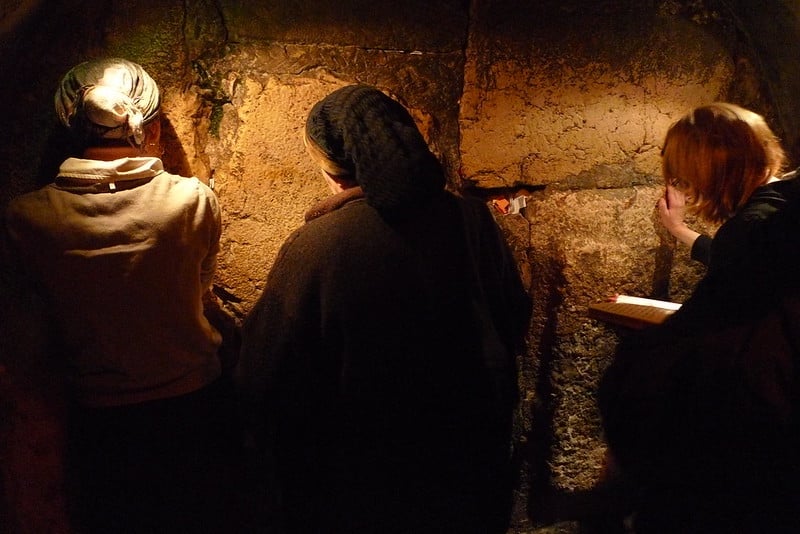
Women praying at the Western Wall Tunnels. Photo courtesy of the Western Wall Heritage Foundation
Recent Tunnel Discoveries
Like a time machine, the tunnels continue to reveal their ancient secrets, giving visitors a unique perspective of ancient Biblical life. Most of the stone used in building was limestone, which was relatively soft when quarried, then hardened with age, enabling its great longevity. Jewish historian Nahum Applebaum, who served as our Western Walls guide, told us that the lower you go, the earlier historical eras you discover from the Ottomans to the Muslims to the Crusaders, back to King Herod and the Romans.
In 2022, while building an elevator to provide greater access to the Western Wall, archeologists found a Jewish ritual bath called a mikvah. The mikvah was used for purification before entering the Temple Mount and came from natural spring water. Historians believe it was part of a home inhabited before the destruction of the Temple. Fragments of mosaics and ornate wall paintings indicate the wealth of the owners.
Another discovery is an ancient entrance, Warren’s Gate (named for one of the original British researchers) which is located underground about 150 feet below in the tunnel and west of the Wall closest to the Holy of Holies. The Holy of Holies was the most sacred place in the Temple, where the Ark of the Covenant was kept and was only accessible to the High Priest of Israel, once a year on Yom Kippur.
When Jerusalem was occupied temporarily during the Crusades, Jews were allowed to pray in the tunnels. Warren’s Gate remains a popular place to pray because of its close proximity to the Holy of Holies.
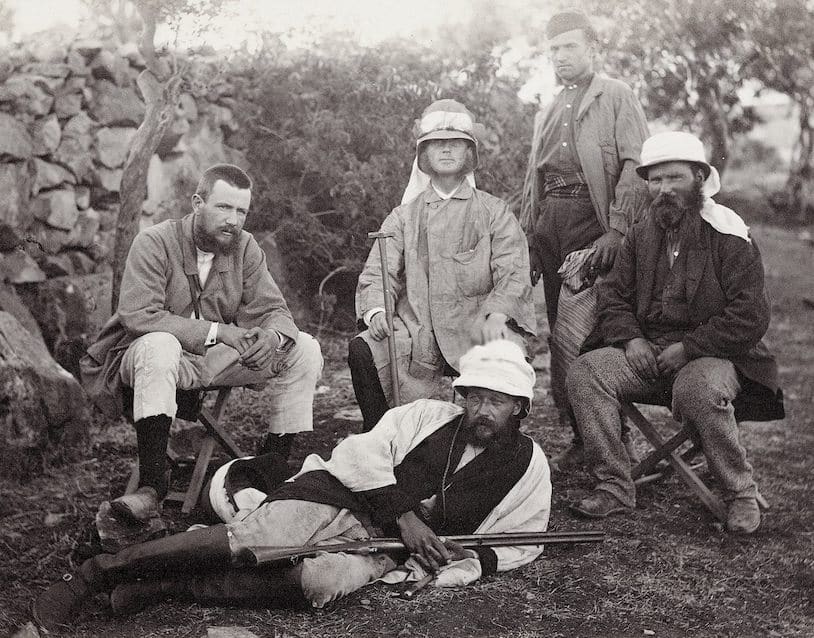
Charles Warren (left) and his group of engineers who made the first discoveries under The Wall. Photo via Wikimedia
In 2020, four gold coins were found in a small pottery jar in the tunnels. Dr. Robert Kool, Israel Antiquities Authority’s coin expert, determined that they dated from the Islamist era, the late 940s through 970s AD which was a time of great political upheaval. This was the first time in 50 years that gold from this period has been discovered in Jerusalem’s Old City.
In 2004, excavations also revealed a 5th-century Byzantine Christian Church built to commemorate the site near the Pool of Siloam where Jesus cured a blind man. After the destruction of Jerusalem in 70 AD, the Pool of Siloam lay in ruins and was covered over. According to the New Testament, the pool was considered a sacred Christian site, but its exact location was not confirmed until this discovery
Relics also were discovered from the era of the First Temple, which stood in the same spot.
Significance of the Wall to Islam
The Western Wall is called “Al Buraq” in Islam, in reference to the prophet Mohammed tying his winged steed to the other side of the Wall on the “Night of Ascension.” Muslims call the Al-Aqsa complex the Haram al-Sharif, the Noble Enclosure. Most of the tunnels and their relics are located under buildings in the Muslim Quarter in the Old City.
Take a Tour of the Western Wall Tunnel
To visit the Western Wall Tunnels, schedule a guided tour sponsored by the Western Wall Heritage Foundation. Tours take about 90-minutes. You’ll learn about ancient Jerusalem and more about recent discoveries. The entrance to the tunnels is on the northern side of the Western Wall Plaza next to the Western Wall.
Upon entering, you walk through several rooms and then veer to the left or straight, depending on the route you’ve chosen to take. We viewed a virtual scale model of the Second Temple Plaza giving an overview of the site.
The traditional Great Stone Route takes you through the length of the Wall to see unique subterranean spaces, large stone arches, an ancient water aqueduct, and the huge Western Stone.
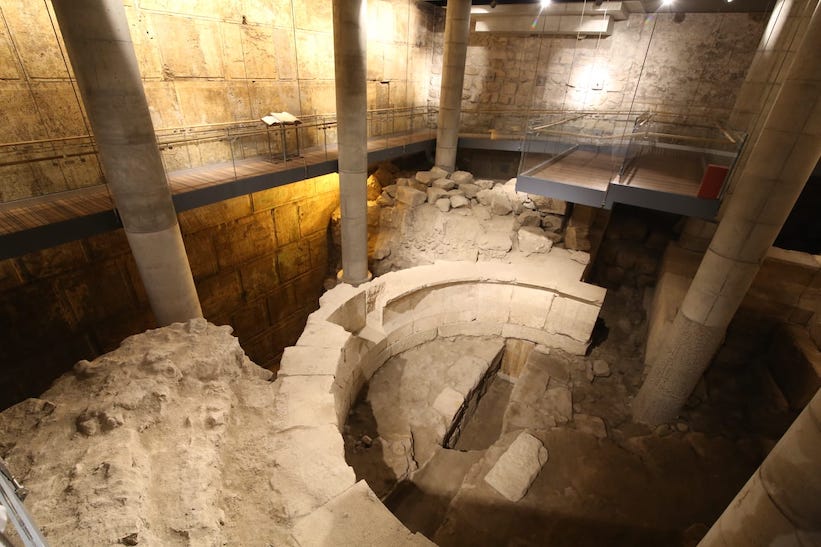
Ruins of a Roman amphitheater, never finished because of civil unrest. Photo courtesy of the Western Wall Heritage Foundation
The Western Stone is a massive boulder that forms the lower level of the Western Wall, measuring 14 meters long and weighing almost 600 tons. This stone is considered one of the heaviest objects ever moved by humans. How it reached its present location remains a mystery. Some surmise that the Western Stone was the Western Wall’s first stone and the rest of the Wall was built around it.
The newer Great Bridge Route opened only a year ago, takes you one more level below. The Great Bridge Route is so named for the bridge that connected Jerusalem’s upper city with the Temple Mount, which also included an aqueduct that brought water to the area.
“This bridge was built about two thousand years ago because there was a valley below,” explains Nahum Applebaum. “It created an easier route to get to the Temple without having to go down and then up.”
Walking through the well-lit tunnels, the ancient stones evoke a feeling of connection to centuries of history. It was here that worshippers whispered their prayers in Biblical times and expressed their sorrows during times of crisis.
There were paper prayer notes inserted between the stones even this far below ground. Perhaps the Western Wall once extended further below ground than what we see today.
Moving through the underground passages, hidden sections of the Western Wall were visible along with ancient water trenches, and a quarry used to excavate stones for the Kotel.
The historian guiding us pointed out Roman catapult stones. These stones were used as weapons by the Romans who shot them from a catapult.
Another discovery was a small, unfinished Roman amphitheater, which was designed to seat 200. The guide suggested that after the theatre construction began, the Romans were engaged in battle and never bothered to complete the structure.
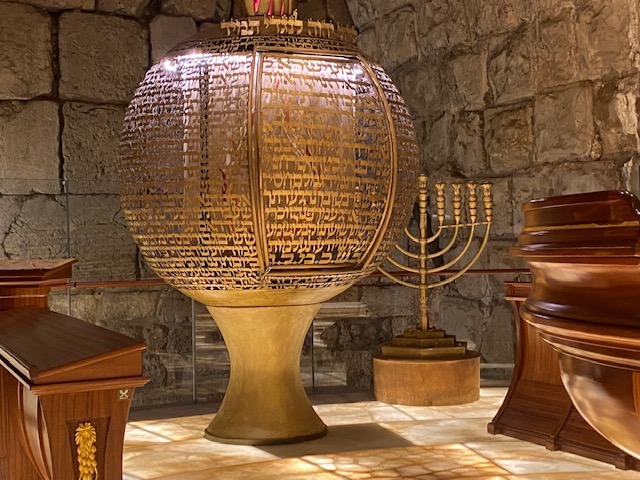
Ark holding the Holy Torahs in the subterranean Sha’arei Teshuva synagogue. Photo by Mira Temkin
Re-Opened Synagogue
Deep inside the complex along the Great Bridge Route is the Sha’arei Teshuva synagogue, which took 12 years and over $50 million to construct. The subterranean synagogue was dedicated in 2017 but closed during Covid and is now open again. The unique design of the sanctuary weaves a round sculpted metal Ark to hold an illuminated Torah Scroll blending the old with the new. It is an inspiring sight. Sunrise services are held daily at 6 a.m. as well as on Shabbat and Holy Days when tunnel tours are not held.
Experience Biblical Times with the Virtual Reality Tour
Next to the Western Wall Tunnels is another fascinating venue called, “A Look into the Past.” Using advanced technology, this virtual reality tour gives a 360-degree perspective of the Second Temple as it once existed filled with worshippers. Visitors can put on special goggles and be transported back 2,000 years to the very same spot. You can look around the ancient streets as they existed in the time of King Herod and Pontius Pilot, see the marketplace where animals offered for sacrifice can be purchased, and listen to trumpeters calling people to worship. Walk a bit further through this virtual world and watch High Priests lighting the Menorah and blessing people dressed in tunics and sandals. Soaring above the throng are the walls of the Second Temple.
After leaving the darkened tunnels and exploring a virtual world I emerged into the bright daylight of the 21st Century with a renewed curiosity for Jerusalem’s rich history. Archaeologists say the more you dig, the more you learn and the more questions you have. After exploring Jerusalem’s past and present, I’m now better equipped to understand their point of view.![]()
Mira Temkin is a Chicago-based travel writer. Her last article for EWNS examined the colorful history of Galveston, Texas.
The tunnels of Jerusalem’s Western Wall offer a portal to a bygone era. But this is just one page in the vast chronicle of the Middle East and Africa’s storied past. We invite you to journey with us further, exploring these regions through a cultural and historical lens. The tales of ancient cities, desert landscapes, and vibrant traditions await – continue your expedition with EWNS for more hidden treasures.

